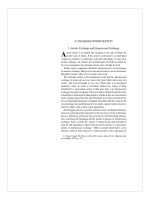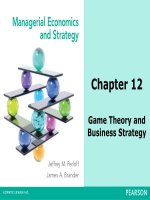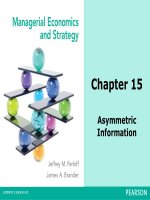Career development interventions 5th by spence niles and bowlsbey chapter 10
Bạn đang xem bản rút gọn của tài liệu. Xem và tải ngay bản đầy đủ của tài liệu tại đây (207.7 KB, 28 trang )
Career Development Interventions
5th Edition
Spence G. Niles and JoAnn E. Harris-Bowlsbey
Publisher to insert
cover image here
Chapter 10
Career Development Interventions
in the Elementary Schools
Developed by:
Jennifer Del Corso
Copyright © 2017, 2013, 2009 by Pearson Education, Inc. All Rights Reserved
Overview of Career Development
Interventions in Schools
• The National Standards for School Counseling Programs
and the American School Counselor Association (ASCA)
National Model for School Counseling (ASCA, 2014) identify
career development as an essential element in effective
school counseling programs
• Most recent standards are ASCA Mindsets and Behaviors
for Student Success (ASCA, 2014)- organized into three
domains:
•
-academic,
•
-career, and
•
-social/emotional development
Career Development Interventions, 5th Edition
Spencer G. Niles and JoAnn E. Harris-Bowlsbey
Copyright © 2017, 2013, 2009 by Pearson Education,
Inc.
All Rights Reserved
National Standards for School
Counseling Programs (ASCA, 2012)
• The National Standards (ASCA, 2012),
which were developed to address the
growing need for standardization and
accountability in school counseling
programs, consist of four components:
• foundation
• delivery system
• management system
• accountability system
Career Development Interventions, 5th Edition
Spencer G. Niles and JoAnn E. Harris-Bowlsbey
Copyright © 2017, 2013, 2009 by Pearson Education,
Inc.
All Rights Reserved
National Career Development
Guidelines
• The U.S. Department of Education’s Office of
Vocational and Adult Education (OVAE) revised
the National Career Development Guidelines
(NCDG) so that they would align with the goals
of No Child Left Behind.
• The NCDG framework addresses three domains:
Personal Social Development (PS), Educational
Achievement and Lifelong Learning (ED), and
Career Management (CM).
Career Development Interventions, 5th Edition
Spencer G. Niles and JoAnn E. Harris-Bowlsbey
Copyright © 2017, 2013, 2009 by Pearson Education,
Inc.
All Rights Reserved
Criticisms of Career Education
• Takes time away from core academic
subjects
• Pressures students to pursue work
immediately after high school rather than
postsecondary education
• Topic not appropriate at elementary and
secondary levels
• Programs not systematic and coordinated
Career Development Interventions, 5th Edition
Spencer G. Niles and JoAnn E. Harris-Bowlsbey
Copyright © 2017, 2013, 2009 by Pearson Education,
Inc.
All Rights Reserved
Important Considerations in Developing Career
Development Interventions in the Schools
• Advocate for making career development
programs an integral part of the school
curriculum rather than an ancillary service
• Help teachers become aware of the research
data that indicate positive correlation between
career planning and school success
• Be aware of how environmental constraints
(e.g., sexism, discrimination) negatively affect
students’ career development
Career Development Interventions, 5th Edition
Spencer G. Niles and JoAnn E. Harris-Bowlsbey
Copyright © 2017, 2013, 2009 by Pearson Education,
Inc.
All Rights Reserved
Five-Stage Planning Model
• Stage 1: Develop a program rationale and
philosophy.
• Stage 2: State program goals and
behavioral objectives.
• Stage 3: Select program processes.
• Stage 4: Develop an evaluation design.
• Stage 5: Identify program milestones.
Career Development Interventions, 5th Edition
Spencer G. Niles and JoAnn E. Harris-Bowlsbey
Copyright © 2017, 2013, 2009 by Pearson Education,
Inc.
All Rights Reserved
How to Develop a Systematic
Career Intervention
• Involve knowledgeable professionals,
parents, and representatives from the
community in all phases of planning.
• Use developmentally appropriate
interventions.
• Communicate program goals and objectives
clearly to all stakeholders.
Career Development Interventions, 5th Edition
Spencer G. Niles and JoAnn E. Harris-Bowlsbey
Copyright © 2017, 2013, 2009 by Pearson Education,
Inc.
All Rights Reserved
How to Develop a Systematic Career
Intervention
(cont.)
• Assure that the program is based on
student needs.
• Evaluate outcomes to determine the degree
to which program goals and objectives were
achieved.
• Assure the competence of those involved in
program delivery.
Career Development Interventions, 5th Edition
Spencer G. Niles and JoAnn E. Harris-Bowlsbey
Copyright © 2017, 2013, 2009 by Pearson Education,
Inc.
All Rights Reserved
Career Development in the
Elementary School
• Careers unfold and develop throughout the
life span.
• For children and adolescents, school and
leisure activities are their work.
Career Development Interventions, 5th Edition
Spencer G. Niles and JoAnn E. Harris-Bowlsbey
Copyright © 2017, 2013, 2009 by Pearson Education,
Inc.
All Rights Reserved
Children’s Conceptions of Career
Choice and Attainment Model (CCCA)
• Developed by Howard and Walsh (2010, 2011).
• CCCA model organizes children’s concepts of
career choice and attainment around three
approaches: Association, Sequence and
Interaction
• CCCA Model:
Level 1 Association- career exists for the child
Level 2 Sequence- - child can describe career but not
method on how to attain
Level 3 Interaction - child can describe the skills they need
to get a job
Career Development Interventions, 5th Edition
Spencer G. Niles and JoAnn E. Harris-Bowlsbey
Copyright © 2017, 2013, 2009 by Pearson Education,
Inc.
All Rights Reserved
Career Development Before Elementary
School - Erikson
• Children move through the first two of
Erikson’s eight stages prior to entering
elementary school.
• Those who coped successfully with these
stages have developed trust and autonomy.
• When students do not develop trust and
autonomy, they experience consequences of
mistrust, doubt, and shame.
Career Development Interventions, 5th Edition
Spencer G. Niles and JoAnn E. Harris-Bowlsbey
Copyright © 2017, 2013, 2009 by Pearson Education,
Inc.
All Rights Reserved
Developmental Tasks of Infancy
and Early Childhood - Havighurst
• From ages 0-5 children learn to
walk
eat solid food
talk
control elimination of body wastes
identify sex differences and behave with modesty
relate emotionally to family members
prepare to read
identify the difference between right and wrong
Career Development Interventions, 5th Edition
Spencer G. Niles and JoAnn E. Harris-Bowlsbey
Copyright © 2017, 2013, 2009 by Pearson Education,
Inc.
All Rights Reserved
Career Development During
Elementary School (Erikson)
• During elementary school years, students
need to develop initiative (ages 4-6) and
industry (ages 6-12).
• When these tasks are accomplished, they
use curiosity to gather information about
themselves and the world.
• These behaviors result in personal
effectiveness that is rewarded by positive
outcomes.
Career Development Interventions, 5th Edition
Spencer G. Niles and JoAnn E. Harris-Bowlsbey
Copyright © 2017, 2013, 2009 by Pearson Education,
Inc.
All Rights Reserved
Middle Childhood Developmental
Tasks (Havighurst)
• Develop physical skills for participation in
games
• Build positive attitudes toward oneself
• Develop interpersonal skills
• Become more tolerant
• Learn appropriate gender social roles
Career Development Interventions, 5th Edition
Spencer G. Niles and JoAnn E. Harris-Bowlsbey
Copyright © 2017, 2013, 2009 by Pearson Education,
Inc.
All Rights Reserved
Middle Childhood Developmental
Tasks (Havighurst)- cont.
• Develop academic skills in reading, writing,
and mathematics
• Achieve a greater sense of independence
• Develop attitudes toward groups and
institutions
Career Development Interventions, 5th Edition
Spencer G. Niles and JoAnn E. Harris-Bowlsbey
Copyright © 2017, 2013, 2009 by Pearson Education,
Inc.
All Rights Reserved
Career Development in Childhood (Porfeli,
Hartung, and Vondracek, 2008)
• Children know much more about world-of-work than
many people believe
• Career aspirations of children are influenced by
gender-based stereotypes
• Aspirations tend to be stable across elementary years
(i.e. girls move away from math, science, technology,
engineering and boys move away from female
dominated fields (i.e. counseling, teaching, nursing)
Career Development Interventions, 5th Edition
Spencer G. Niles and JoAnn E. Harris-Bowlsbey
Copyright © 2017, 2013, 2009 by Pearson Education,
Inc.
All Rights Reserved
Career Development in Childhood (Porfeli,
Hartung, and Vondracek, 2008)
• Children from economically challenged situations
as well as Hispanic and African American children
tend to identify less prestigious career
aspirations than do their more affluent and
Caucasian peers
• Children tend to seek more glamorous
aspirations instead of realistic ones
Career Development Interventions, 5th Edition
Spencer G. Niles and JoAnn E. Harris-Bowlsbey
Copyright © 2017, 2013, 2009 by Pearson Education,
Inc.
All Rights Reserved
Goals of Career Interventions at Elementary
School Level (Super & Savickas)
• Encourage students to participate in
activities related to their interests
• Help children
become concerned about the future
increase personal control over their lives
convince themselves to achieve in school and
at work
develop competent work habits and attitudes
Career Development Interventions, 5th Edition
Spencer G. Niles and JoAnn E. Harris-Bowlsbey
Copyright © 2017, 2013, 2009 by Pearson Education,
Inc.
All Rights Reserved
Career Interventions in Elementary School
to Minimize Gender Bias
• Help students from prematurely committing to
educational and occupation options (Marcia, 1996)
• Counselors can use the Inventory of Children’s
Activities developed by Tracey and Caulum (2015) to
help minimize gender bias when assesses Holland
types in children
• Programs should highlight nontraditional role
models
• Expose students to a broad range of occupational
environments
• Encourage students to read stories about people
working in non-traditional occupations
Career Development Interventions, 5th Edition
Spencer G. Niles and JoAnn E. Harris-Bowlsbey
Copyright © 2017, 2013, 2009 by Pearson Education,
Inc.
All Rights Reserved
Career Development Goals for
Elementary School Students
• Career development goals for elementary school
children should help children develop basic skills and
awareness in the following areas:
• self-knowledge, skills to interact with others
• basic skills in educational and occupational exploration
• awareness of the benefits of educational achievement
• awareness of the relationship between work and
learning
• basic skills to understand and use career information
• awareness of the importance of personal responsibility
and good study habits
Career Development Interventions, 5th Edition
Spencer G. Niles and JoAnn E. Harris-Bowlsbey
Copyright © 2017, 2013, 2009 by Pearson Education,
Inc.
All Rights Reserved
Career Development Goals for
Elementary School Students
(cont.)
awareness of how work relates to the needs
and functions of society
an understanding of how to make decisions
awareness of the interrelationship of life roles
awareness of different occupations and
changing male/female roles
awareness of the career planning process
Career Development Interventions, 5th Edition
Spencer G. Niles and JoAnn E. Harris-Bowlsbey
Copyright © 2017, 2013, 2009 by Pearson Education,
Inc.
All Rights Reserved
Considerations in Planning Career
Development Interventions
• Become a constant observer of children.
Notice how they approach tasks.
Notice the activities they choose.
Encourage initiative.
Notice the thematic patterns that emerge.
Career Development Interventions, 5th Edition
Spencer G. Niles and JoAnn E. Harris-Bowlsbey
Copyright © 2017, 2013, 2009 by Pearson Education,
Inc.
All Rights Reserved
Considerations in Planning Career
Development Interventions
(cont.)
• Consider the processing of an activity as
important as the activity itself.
Focus feedback on the specifics of a child’s
efforts to develop a sense of industry rather
than inferiority.
Provide opportunities for children to express
their beliefs about themselves in relation to
various occupations.
Career Development Interventions, 5th Edition
Spencer G. Niles and JoAnn E. Harris-Bowlsbey
Copyright © 2017, 2013, 2009 by Pearson Education,
Inc.
All Rights Reserved
Examples of Activities
• School Wide Career Day
• Field Trips
• Reading Biographies of various workers
Career Development Interventions, 5th Edition
Spencer G. Niles and JoAnn E. Harris-Bowlsbey
Copyright © 2017, 2013, 2009 by Pearson Education,
Inc.
All Rights Reserved









